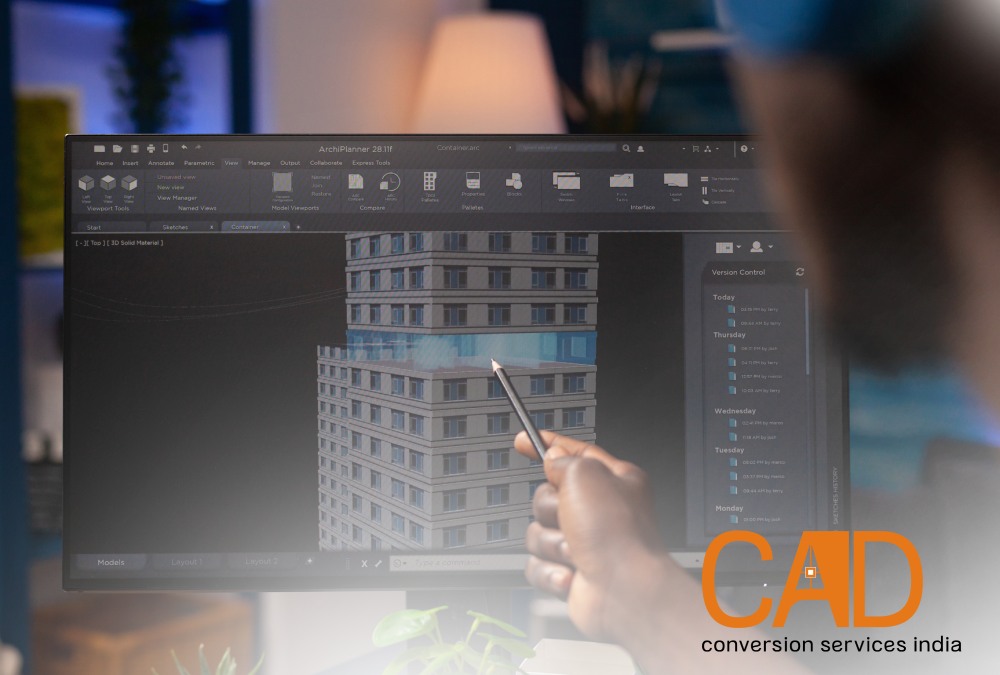BIM Enables Architects to Make Data-Driven Decisions
- CAD
- Structural BIM Service in India
- 0 Comments
Over the years, in the dynamic world of architecture, the role of technology has evolved significantly. The arrival of Building Information Modeling (BIM) represents a revolutionary instrument that enables architects to make well-informed decisions based on data throughout the entire design & construction phases. In this discussion, we will delve into the influence of BIM modeling on architectural design, the advantages it provides to builders, and its role in supporting decision-making grounded in factual information.
Evolving Architectural Design Practices
As architecture constantly evolves, BIM emerges as a game-changer, revolutionizing how designers bring their ideas to life from the ground up. BIM has emerged as a digital powerhouse, revolutionizing traditional design practices by providing architects with a dynamic and comprehensive platform.
Get ready to dive into the world of BIM and its dramatic effect on architecture! We’ll uncover how this technology, from detailed plans to collaborative software like Revit, goes beyond being just a tool. It’s a game-changer, boosting innovation, precision, and efficiency. We’ll show you how BIM is reshaping the entire architectural landscape, giving designers a digital platform to bring their visions to life with incredible detail and clarity.
Architectural Plans Enhanced Through BIM
Architects are no strangers to the intricate process of translating their creative visions into tangible structures such as Structural BIM Service in India. Traditionally, the design by designers involved intricate hand-drawn plans and numerous revisions. Nevertheless, with the advent of BIM, the game has changed. BIM modeling allows builders to create comprehensive and detailed architectural plans in a digital environment.
Architectural BIM Services Elevating Design Precision
Architectural BIM services play a pivotal role in elevating the precision of design. Through architectural BIM modeling services, artists can create 3D digital representations of their projects, offering a holistic view of the structure. This not only enhances the communication of design intent but also enables stakeholders to visualize the outcome more effectively.
Empowering Visualization of Architects with Autodesk Revit
The heart of BIM lies in the powerful software tools that architects employ. Autodesk Revit, a leading BIM software, has become an industry standard for architectural design. Its intuitive interface allows planner to seamlessly integrate BIM modeling into their workflow, providing a collaborative platform for design exploration.
Architectural Data-driven and Autodesk Revit Synergy
Architectural BIM project services often leverage Autodesk Revit to create detailed and accurate models. This synergy ensures that draft person can easily integrate their design concepts into a BIM environment, fostering collaboration among team members. The result is a cohesive and coordinated approach to design, laying the foundation for data-driven decision-making.
Construction Simulation Leveraging BIM
Embarking on the construction journey involves more than bricks and mortar; it requires a nuanced understanding of how a building will perform in the real world. Enter Construction Simulation, a pivotal aspect of Building Information Modeling (BIM) that transcends traditional construction processes. This section unravels the significance of Construction Simulation within the BIM framework, a tool that empowers architects to anticipate and optimize construction performance before a single foundation is laid.
By seamlessly integrating real-world data and regulations, planners can navigate the complexities of design with foresight, ensuring that the result not only meets aesthetic aspirations but also aligns with industry standards. Join us as we delve into how Construction Simulation, as facilitated by BIM, acts as a visionary guide, enabling architects to make informed decisions that resonate throughout the entire construction lifecycle.
Building Performance Analysis Through BIM
One of the remarkable features of BIM is its ability to facilitate construction simulation. Architects can analyze the performance of the building even before the construction begins. This is particularly valuable when it comes to meeting stringent Building Regulations and ensuring that the structure complies with industry standards, so one should try Outsourcing Cad Conversion Service in India.
BIM Architectural Modeling Services and Building Performance Optimization
Architectural BIM modeling services extend beyond just creating visual representations. They enable architects to simulate various construction scenarios, assessing the impact on construction efficiency. This iterative approach allows for optimization based on real-time data, ensuring that the final structure not only meets design aesthetics but also adheres to regulatory requirements.
Architecture Simulation for Iterative Design
Architecture simulation, enabled by BIM, opens up new possibilities for iterative design. Architects can test different design options virtually, analyzing their impact on factors such as energy efficiency and structural integrity. This iterative process empowers drafter to refine their designs based on data-driven insights, leading to more sustainable and efficient buildings.
The Benefits of BIM for Architects
Embracing Building Information Modeling (BIM) marks a transformative leap for architects, offering streamlined collaboration, enhanced design efficiency, and unprecedented access to real-time data. This section explores how BIM, powered by software like Autodesk Revit, empowers creators to make informed decisions, optimize construction functionality, and navigate regulatory landscapes. Join us in uncovering the multifaceted benefits that position BIM as a catalyst for precision, collaboration, and analytics-based design in the evolving realm of architecture.
Streamlining Collaboration and Communication
Architectural BIM modeling services foster collaboration among multidisciplinary teams. Through a shared BIM environment, architects, engineers, and other stakeholders can work concurrently on the same model, streamlining communication and reducing the risk of errors. This collaborative approach ensures that all decisions are well-informed and aligned with the overall project goals.
Enhancing Design Phase Efficiency and Accuracy
BIM software, such as Autodesk Revit, enhances design efficiency by providing tools for automating repetitive tasks and ensuring accuracy. This allows architects to focus more on the creative aspects of design, confident that the technical details are being handled seamlessly within the BIM environment. The result is a more efficient design process that minimizes errors and maximizes precision.
Real-Time Data for Informed Decision-Making
Perhaps the most significant advantage of BIM for architects is the access to real-time data throughout the project lifecycle. From initial conceptualization to construction and beyond, planner can make decisions based on accurate and up-to-date information. This information-based approach empowers architects to anticipate challenges, optimize designs, and ensure the overall success of the project.
Conclusion: The Future of Architecture with BIM
In conclusion, BIM has become an indispensable tool for architects, revolutionizing the way they approach design and construction. Architectural BIM services, coupled with advanced BIM software like Autodesk Revit, provide a comprehensive platform for architects to create, analyze, and optimize their designs. Through construction simulation and architecture simulation, architects can navigate the complexities of building performance and regulatory compliance with confidence.
As the architecture industry continues to evolve, embracing BIM is not just a choice but a necessity. The ability to make data-driven decisions not only enhances the efficiency of the design process but also ensures that the result is a well-informed, sustainable, and compliant architectural masterpiece. With BIM at the forefront, architects are empowered to shape the future of the built environment with precision, creativity, and a wealth of metrics-based insights.




